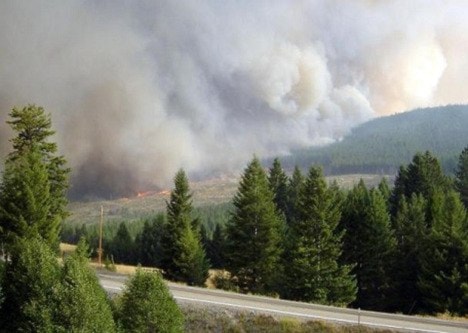The Ministry of Environment, in collaboration with the Interior Health Authority, has issued a smoky skies advisory for the Southern Interior and Kootenay regions. Southerly winds have continued to spread further north heavy plumes of smoke from the large wildfires burning in Washington state, resulting in high concentrations of fine particulates and poor air quality.
While this episode is expected to persist until a major shift in wind patterns and weather conditions, smoke concentrations will vary widely as winds, fire behaviour and temperatures change.
These advisories will remain in effect until further notice and covers other areas such as the entire Okanagan Valley, north and South Thompson, Similkameen, Fraser Canyon, Nicola, Shuswap and the entire Boundary and Kootenay areas.
Though the smoke is expected to thin out over the next few days, it can be tough to predict what the air quality will be given the volume of wildfires in B.C. and Washington State, according to Tarek Ayache, an Air Quality Meteorologist with the Ministry of Environment who is based out of Penticton.
"Generally, it's tough to forecast anything that has to do with wildfire smoke because it all depends on the wildfire activity, it depends on wind direction, it depends on the regional weather forecasts, if there's precipitation or other factors.
"This is an intense and wide-scale regional episode because there's a great number of fires burning throughout Washington State and B.C. as well and they're all contributing to smoke."
Ayache notes that the region is experiencing a stable weather pattern but adds that the smoke will linger for at least a few more days and that the air quality will remain poor.
"Typically if you have an episode that's because of smoke that's coming from a few fires at a certain location, it can vary a lot because one hour the wind can be blowing the smoke a certain way, the next hour it could be blowing it a different way," he said.
"But with this episode, because it's due to a great number of fires burning at once intensely and widely in Washington State, there's a great deal of smoke that's blowing in a certain way. So you can expect some variation for sure, but not as much as you would see from a smaller number of fires."
Given the volume of the smoke, there are also health concerns to consider, according to Dr. Kamran Golmohammadi, a Medical Health Officer with Interior Health.
"The main health concern is particulate matter, those are tiny solid or liquid particles that remain suspended in the air for an extended period of time," Golmohammadi said. "…The reason we are concerned with those particles is that they can lodge deep in our lungs and cause respiratory and cardiac problems."
If you are experiencing any of the following symptoms, contact your health care provider: difficulty in breathing, chest pain or discomfort, and sudden onset of cough or irritation of airways.
Exposure is particularly a concern for infants, the elderly and those who have underlying medical conditions such as diabetes, and lung or heart disease.
To mitigate the adverse effects of the heavy smoke, Golmohammadi recommends people stay indoors and avoid strenuous physical activity.
"By reducing the amount of air going through your lungs, you will have less amount of those particles lodging and depositing in your lungs, so those are two main things but of course, always use common sense and watch your symptoms," Golmohammadi said.
Much of the smoke can be sourced to the Stickpin fire in northern Washington in the Ferry County—located five kilometre south of the border near Grand Forks—and has burned 19,240 hectares.
Due to the heavy smoke, B.C. have been unable to support crews on the ground with air tankers or helicopter buckets, according to a government release issued on Monday.
However, the B.C. Wildfire Service has begun work on the fire with a Canadian contingent of firefighters and are focused on developing situational awareness, identifying anchor points and establishing control lines to keep the fire from spreading north of the border.
Growth to the Canadian side has been minimal over the last few days in part to lower temperatures and winds and the fact that the northern part of the fire is burning into an area with fewer fuels as a result from a previous wildfire.
In addition to the Stickpin fire, there is a blaze classified as a Wildfire of Note just outside Creston on Mount Midgeley mapped at 480 hectares. A lightning-caused fire, it is nearly under control, with burnout operations on Monday to help secure the northern flank to help establish 100 per cent containment.
